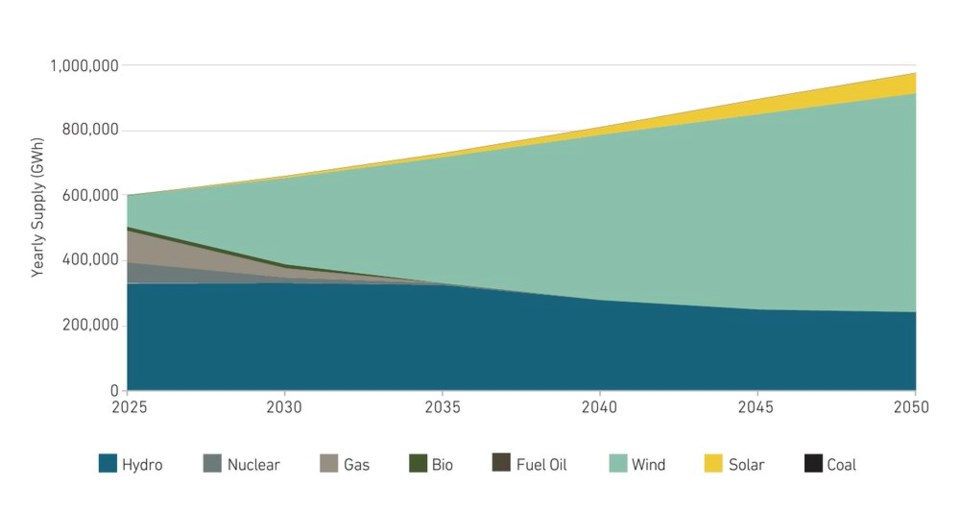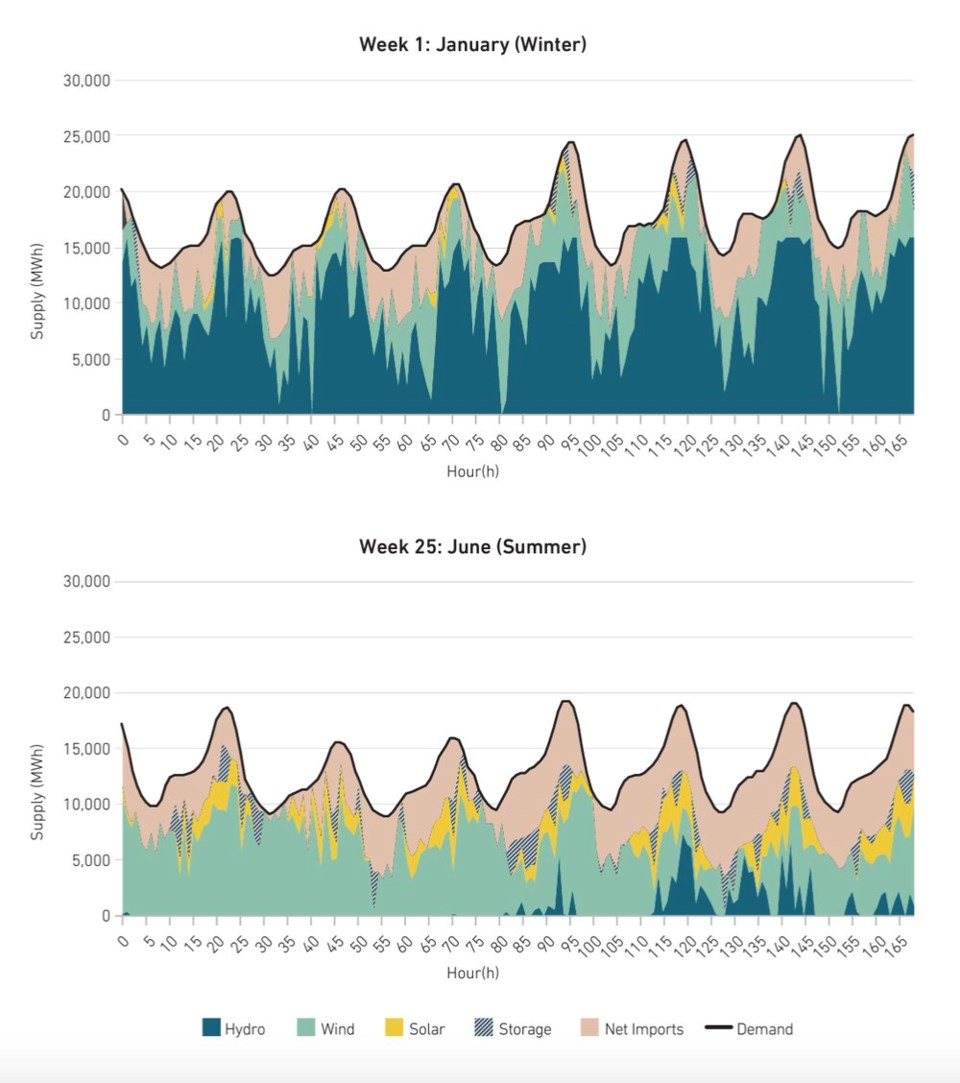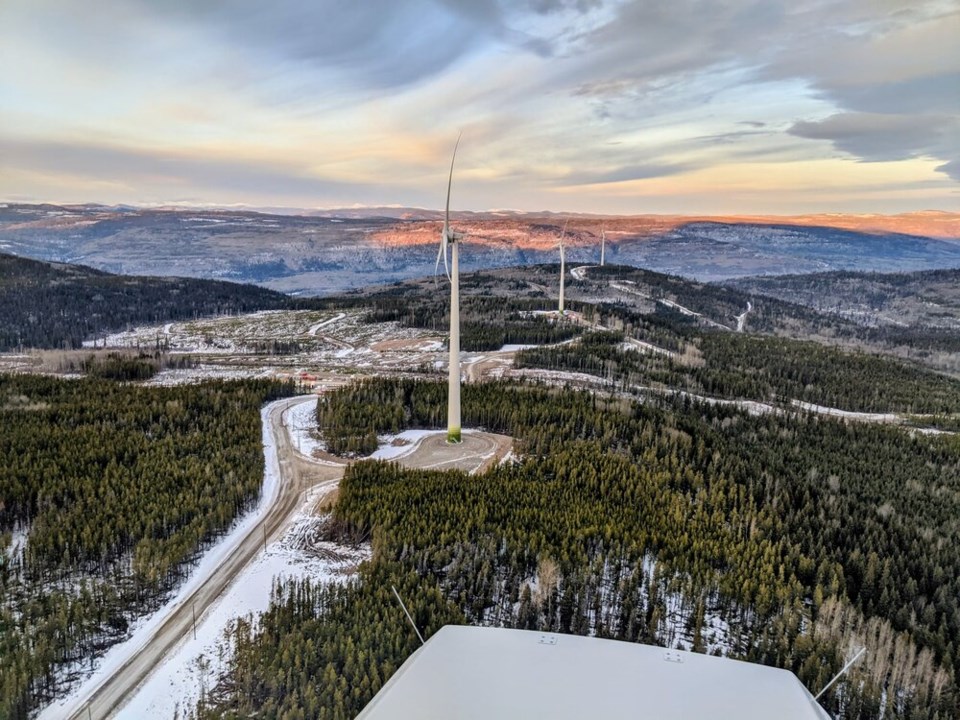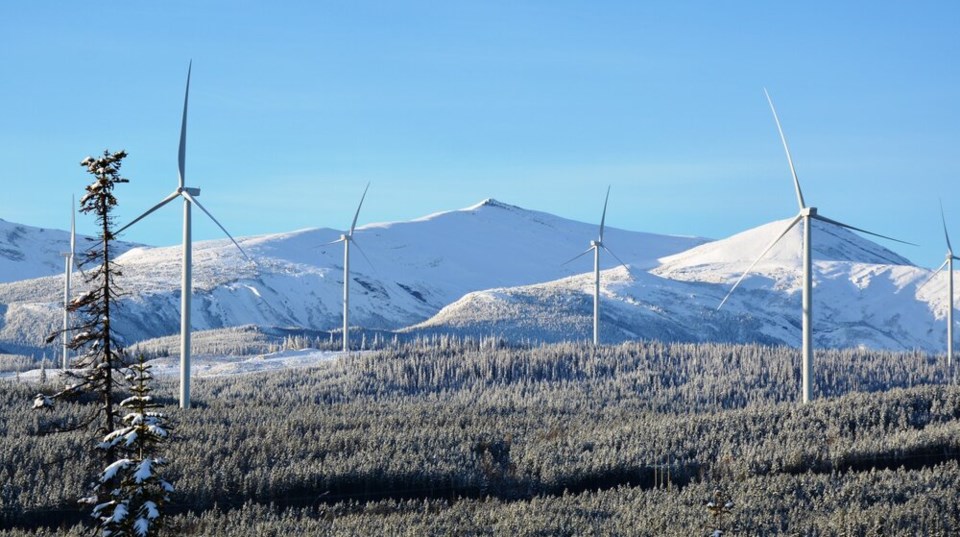To decarbonize Canada's grid, the country will have to increase its wind and solar capacity 18-fold by 2050, according to new modelling.
Described as the first of its kind in Canada, the David Suzuki Foundation "Shifting Power" calls for a profound shift in the way utilities collaborate and regulate energy generation and transmission across the country.
"We're talking about nearly a tripling in the electricity system in Canada — and all of that's coming from wind and solar," said co-author Stephen Thomas, a mechanical engineer and climate solutions policy analyst at the David Suzuki Foundation.
"This report shows more clearly than ever that 100 per cent zero-emissions electricity is possible, affordable and reliable."
Canada has made some progress in recent years.
Between 2005 and 2020, Canada's public utilities halved emissions from electricity generation, gains largely made by phasing out coal and oil-powered plants.
Even so, heating buildings and supplying electricity to the grid combine to create Canada's third-largest . In 2020 — the most recent data available — only transport and the oil and gas sector represented larger sources.
As the world increasingly electrifies, so will people's thirst to power their devices, homes, workplaces and cars.
To satisfy that uptick in energy consumption and move away from fossil fuels will require the construction of more than 2,000 wind turbines and 160 10-megawatt solar farms (a combined 650 hectares of solar panels) every year across Canada, finds the report.

Four years in the making, Thomas and his colleagues spent three of those years collaborating with a group of independent researchers at the University of Victoria's Institute for Integrated Energy Systems. Led by Madeleine McPherson — who this week was picked to help lead a national "to help realize a decarbonized energy system for Canada" — the group took that time to ensure the models would work and to detail how energy security would be achieved across every province.
Their results line up with another recent released by the Canadian Climate Institute earlier this month, which found Canada's electricity systems need to grow 2.2 to 3.4 times what they are today by 2050 — all in a world where wind and solar make up to 75 per cent of all energy generation.
Ultimately, the report's recommendations gird a transformation in not only how energy is generated but where it comes from. Provinces, it notes, would need to collaborate like never before to take advantage of cheap energy on windy or sunny days.
"This report sets out the kind of analysis we have been waiting for," said Roland Clift, a UBC adjunct professor at the Department of Chemical and Biological Engineering and past member of the UN Intergovernmental Panel on Climate Change.
"It is convincing because it is authoritative and, above all, pragmatic and realistic."
Clift said the modelling parallels the kind of grid-operated successes in places like Spain and Portugal. Its conclusions for B.C., he says, are consistent with past Clift has conducted at UBC's Clean Energy Research Centre (CERC).
"This report should be seen as both a challenge and an encouragement because it sets out what is possible," he added. "It would be a tragedy for us all if the biggest barrier turned out to be lack of political will."
CERC director Xiaotao Bi said the report offered a "long-awaited realistic analysis on Canada's electricity future to meet 2050 net-zero target."
Bi said B.C. should look to biofuels to help lower emissions in aviation, marine and long-distance road transport, where technologies to reduce emissions have been slow to get off the ground. He also offered a warning: as the world looks to scale up solar and wind technology, supply chains to build turbines and solar panels could be in short supply.
Claudio Cañizares, professor and executive director at the Waterloo Institute for Sustainable Energy, was less optimistic.
Describing the modelling as "not very realistic," Cañizares said hydro and nuclear projects are already slated to expand in Quebec and Ontario, respectively.
"They're not going to walk away from that," he said.
Even more unrealistic is the idea that provinces will build deep transmission across borders, which has been discussed for decades but hasn't happened yet, said Cañizares.
"They assume Canada is one big country and we can do whatever we want between provinces, but that's not the reality," he said, pointing to political divides between Alberta and B.C. and Quebec's preference to sell hydropower to New England over Ontario.
"The federal government cannot tell the provinces how to do this."
Anil Hira, lead researcher at Simon Fraser University’s Clean Energy Research Group, was equally concerned about the “monumental efforts” required for energy storage and building transmission lines between provinces.
“The authors don’t talk about the economic trade-offs and political resistance from downsizing the fossil fuel industry,” he said.
Others, like Caroline Lee, an energy policy analyst at the Canadian Climate Institute, acknowledged the limits of the roadmap to decarbonization. But having worked with the group's underlying data in the past, Lee described the modelling as "generally robust."
The models show wind and solar take on an enormous role in supplying the electricity grid in almost every province — technologies Thomas says have been proven and are ready to scale up.
Between Alberta and B.C., for example, huge amounts of electricity would flow from wind and solar farms in the Prairies — where it's cheap and easily deployed — to feed peak demand across the border. Alberta, for its part, would benefit from the energy stored in B.C.'s hydroelectric reservoirs, which, together with inter-regional transmission, would even out supply when it's not windy or water levels are low.

Energy-efficiency programs and building retrofits would temper demand, and everything would be bolstered by up to a 219-fold increase in the number of lithium-ion batteries deployed to the grid.
Though the demand for such batteries would only require five per cent of the output from a newly announced $4 billion , Thomas says it's far from the only technology that could fill the role of energy storage in places where hydroelectric reservoirs are scarce.
From mechanical devices that store potential energy by to systems of that store energy in the form of water pressure, many solutions are still being developed and could fill in for batteries or hydro reservoirs.
Other companies, like , are looking to harness the rust cycle to power a new form of battery.
But the David Suzuki Foundation report takes a conservative approach, and its modelling doesn't rely on any of these technologies.
In every modelled scenario, wind would dominate energy production Canada-wide, amounting for up to 60 per cent of grid electricity generation by 2050.
In B.C., that would mean building an estimated 290 new wind turbines every year between now and 2050. That's in addition to building 20 10-megawatt solar farms every 12 months under the roadmap — an infrastructure proposition that would cover roughly 800 hectares of land annually.
B.C. starts from a "great position" with a very low emissions electricity grid, says Thomas. But due to the ideal conditions in Alberta, the province would still likely become a net importer of renewable energy from its neighbour.
"We're going to need a lot," he said.
The pathway would require no new large-scale hydroelectric dams or nuclear energy, and the former would be phased out by the 2040s.
All told, the boldest pathway would mean avoiding the release of three billion tonnes of greenhouse gas emissions between 2025 and mid-century — equivalent to four years of Canada's total greenhouse gas output, or more than a quarter of what the country needs to eliminate from its emissions portfolio over the next three decades.
"Although the scale of this transformation is daunting, with real challenges that need to be overcome, it is possible to deploy these technologies at this pace and scale," states the report.
It will require significant investment but not an insurmountable total, found the report.
From 2025 to 2034, the upfront capital costs to build all those wind turbines, solar farms and transmission infrastructure would add up to three to four per cent more than the cost of the country's current energy mix.
"The cost projections are very comparable to business as usual," Thomas said.
But by 2035, when Canada could theoretically produce 100 per cent zero-emissions electricity, costs drop off and become cheaper even as electricity demand soars.
Another recent this month from the Canadian Climate Institute found B.C. companies looking to transition to a low-carbon economy have had the most success of any province in raising money. And when adjusted for GDP, the global competitiveness of B.C. companies looking to advance decarbonizing technology goes through the roof.
With new companies come new jobs. According to Thomas's modelling, transitioning to a renewable grid would generate up to 75,000 full-time jobs a year split between the wind, solar, transmission and pumped hydro storage sectors.
That doesn't include jobs in the electric vehicle industry, retrofitting homes and a growing demand for the manufacturing of wind turbines, solar panels and batteries necessary to carry out the energy transformation.
"We see a huge labour requirement coming up as part of this work," said Thomas.
The tricky process of choosing where to build
Building wind, solar and transmission lines at the scale proposed is expected to affect large areas of land. That will inevitably impact communities, and the landscapes people and wildlife rely on.
In agriculture areas, the report says wind farms could be installed with relatively little negative impact, but build a solar farm on that land, and you could block access to prime soils to produce food.
At the same time, critical habitat for migratory birds is not a good place to build wind turbines or transmission lines.
Instead, existing highway corridors or railway right-of-ways offer an opportunity to build transmission lines without further cutting through existing habitat.
The report says there are many ways to help choose the right location to maximize energy production while limiting environmental impacts. One solution for communities making that hard choice: a tool to "help renewable energy planners and developers locate projects to avoid key habitats."
In all cases, says Thomas, communities need to be intimately involved in planning the installation of wind turbines and solar farms so they can help guide their success while reaping at least some of the benefits.
Some communities could choose to raise money through energy cooperatives as they sell energy back to the grid.
Indigenous communities across Canada are already involved in nearly 200 clean energy projects over one megawatt, making them the largest owner of clean energy assets in Canada after Crown and private utilities, according to Clean Energy Canada.
But instead of seeking "minor benefits and agreements," many of these communities are now seeking ownership, says a that consulted with 17 Indigenous clean energy economic development corporations.
Those researchers pointed to two 15 megawatt wind-power projects developed in partnership with the West Moberly First Nation and Saulteau First Nation in northeastern B.C.
"Each of these projects will generate clean, renewable energy that is sold to BC Hydro and Power Authority under separate 40-year energy-purchase agreements," says the Indigenous-led report.

By focusing on clean energy, the two nations have a path to sustainable economic development that aligns with their effort to save the endangered Klinse-Za caribou herd from extinction — efforts that include airlifting female cows by helicopter to a mountaintop pen enclosure and providing them with handpicked lichen.
There are big barriers, such as building a wind farm during a global pandemic or, in the case of many remote, fly-in communities, sourcing and transporting large materials by barge or winter ice roads.
Those theoretical barriers became real when three Métis and First Nations in Alberta came together to build a $7.8 million solar project near Wood Buffalo National Park — the country's largest remote community solar farm.
"The winter roads and ice bridges have also become unreliable due to changing climate conditions," stated the report.
Since it was completed in late 2020, the project has reduced the community's reliance on outside diesel. Every year, 25 fewer large tank truck trips are heading to and from Fort Chipewyan, Alta.
At the same time, the Three Nations Energy project has allowed a number of community members to improve their technical skills and get involved in the clean energy industry. It's just one example of how clean energy projects help Indigenous communities strike their course toward self-governance and economic self-sufficiency.
Building such projects will require "incorporating and centring Indigenous world views, values, governance and decision-making authority," found the report.
As the researchers concluded: "An Indigenous-led clean energy transition will require the status quo to look and operate entirely differently…"
A conservative net-zero future
While off-grid and territorial grids will play an important role in Canada's decarbonization, none of the modelling in the report considered regions north of 60 degrees latitude.
That's because those grids aren't connected to the 10 provincial grids.
The roadmap also did not consider the potential of offshore wind farms, rooftop solar on residential or commercial buildings or green hydrogen. In each case, the researchers say they didn't have the modelling resources they needed.
Also left out of the models:
- all energy storage technologies outside of pumped hydro retrofits and battery storage;
- emerging technologies, like the direct air capture demonstration plant sucking carbon out of the air in Squamish, B.C.;
- and how changes in consumer behaviour could drive a reduction in electricity demand.
Will Canada's Clean Electricity Standard be enough?
The release of the roadmap to decarbonize Canada's grid comes as the federal government develops a Clean Electricity Standard to meet its target of net-zero by 2035.
It's a goal Minister of Environment and Climate Change Steven Guilbeault recommitted to May 27 in a following high-level talks with his G7 counterparts in Berlin, Germany.
Thomas said the David Suzuki Foundation researchers shared their findings with people involved in those deliberations. But he worries recent federal moves to foster carbon capture and removal technology — which promises to scrub carbon from smokestacks — will give a green light for fossil fuel generating facilities to keep emitting carbon.
Federal net-zero goals could either mean transforming an electricity grid that effectively produces no greenhouse gas emissions, or deploying new technologies “that remove carbon from the atmosphere,” according to a federal government released in March.
"We're concerned that this federal Clean Electricity Standard will make too many allowances for the continued or even expanded use of fossil fuels on the grid," he said.
While Thomas acknowledges the scope and scale of transforming Canada's grid is very ambitious, he also says it's very achievable.
"To meet these targets, we need to do this in the next 12 to 13 years," he said. "There's really no time to wait. Wind and solar tech are mature and stable and ready to be deployed right now."
"We need to get to work really soon."

-05-18_at_35540_pm.jpg;w=120;h=80;mode=crop)



